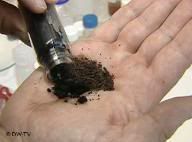Green designer coal: more on hydrothermal carbonisation of biomass
 Previously we had a look at the work of German scientists from the Max Planck Institute who developed a simple but ingenious and efficient way to produce renewable coal from biomass, called hydrothermal carbonisation. The potential for this technology is so large that some think it could cover countries' entire energy needs and may lower the reliance on climate destructive coal. An example: if the 70 million tonnes of biomass that Germany produces every year were to be converted into 'bio-coal', this would be sufficient to cover the country's entire energy needs.
Previously we had a look at the work of German scientists from the Max Planck Institute who developed a simple but ingenious and efficient way to produce renewable coal from biomass, called hydrothermal carbonisation. The potential for this technology is so large that some think it could cover countries' entire energy needs and may lower the reliance on climate destructive coal. An example: if the 70 million tonnes of biomass that Germany produces every year were to be converted into 'bio-coal', this would be sufficient to cover the country's entire energy needs.What is more the green coal can be designed according to specific needs: it can be made to resemble hard coal for use in traditional power plants, converted into liquid fuels or mimic carbon-rich top-soil that can boost the fertility of nutrient-poor soils. Ultimately a carbon fuel cell could be envisioned in which the bio-based black powder would be converted into electricity without being burned. This would avoid the drawbacks of fuel cells that make use of a gas like hydrogen that is difficult to handle.
 In "A Stroke of Genius? A New Recipe for Coal" the Deutsche Welle has an interesting talk with Markus Antonietti (photo), director of the Max Planck Institute for Colloid and Interface Research who helped design the conversion process. A video is available, in which the researcher describes the process as follows:
In "A Stroke of Genius? A New Recipe for Coal" the Deutsche Welle has an interesting talk with Markus Antonietti (photo), director of the Max Planck Institute for Colloid and Interface Research who helped design the conversion process. A video is available, in which the researcher describes the process as follows:Biomass goes into the autoclave, a kind of pressure cooker. Leaves, pine cones and other plant residues are put into the pot. Water goes in, too, along with a citric acid catalyst. The mixture releases a lot of heat - in other words, energy.Could this laboratory coal be produced on a large scale? According to Antonietti, it makes economic sense. If it were up to him the 50,000 tonnes of plant refuse that accumulate yearly in Berlin would be converted into 20,000 tonnes of usable carbon. The energy needed for the heating is no greater that that required by other bioconversion methods. Until that day comes, the Max Planck scientists intend to go on with their research. They want to study their laboratory coal in detail.
We underestimated this when we started. We could calculate how much energy was stored in the sugar - in the leaf material. But the first time - as you see - we had a runaway reaction, which is obviously dangerous, so we need to carry it out under safe conditions.
It really is a simple reaction. The ingredients just have to be heated for 12 hours at 180 degrees Celsius. And the coal is ready. The single major by-product of the reaction is water, which can filtered off. In contrast to other biomass techniques this reaction does not generate carbon dioxide. And it gives a higher-energy product, which even smells acceptable.
Because not all coal is alike. The researchers can adjust the bio-coal to be just a bit refined, or they can cook it until it's like hard coal. One end of the spectrum is topsoil, the other is anthracite. This opens new perspectives: a nutrient-rich earth-like coal can be used to help barren landscapes bloom; soft lignite can be burned in efficient CHP plants, whereas hard coal may be used in large existing power plants.
Markus Antonietti's team is now going to work on the transformation of the bio-coal into synthetic petroleum ('bio-coal to liquids') but the ultimate goal is to design a carbon fuel cell that would directly convert the bio-coal via an electrochemical process [entry ends here].
 bioenergy :: biofuels :: energy :: sustainability :: hydrothermal carbonisation :: biomass :: carbon :: coal :: bio-coal ::
bioenergy :: biofuels :: energy :: sustainability :: hydrothermal carbonisation :: biomass :: carbon :: coal :: bio-coal ::  --------------
--------------
 Mongabay, a leading resource for news and perspectives on environmental and conservation issues related to the tropics, has launched Tropical Conservation Science - a new, open access academic e-journal. It will cover a wide variety of scientific and social studies on tropical ecosystems, their biodiversity and the threats posed to them.
Mongabay, a leading resource for news and perspectives on environmental and conservation issues related to the tropics, has launched Tropical Conservation Science - a new, open access academic e-journal. It will cover a wide variety of scientific and social studies on tropical ecosystems, their biodiversity and the threats posed to them.









2 Comments:
Absolutly wonnderful hope he has filed patent Big oil Shell/Virent seem to be streets ahead see Green Car congress on APR(Aquaeous Phase Reforming)
We develop the first HTC- Biology- Green-Powerplant in the world. The power will be 1MWelec. and its need 16000t Biomass
Post a Comment
Links to this post:
Create a Link
<< Home